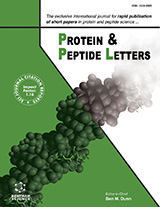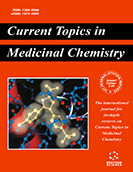Abstract
Caspases, Asp-specific cysteine protease, cleave proteins upon apoptosis. To identify and characterize new caspase substrate in the nucleus, the proteome of the rat liver extracts was analyzed after the treatment with caspases. One of the identified proteins was KSRP / FBP2 that is preferentially cleaved by caspase-3 and -7 at two sites after Asp102 and Asp183. The second site was cleaved only in the protein produced in cells, but not in in vitro translated protein. These results indicate that more than the primary sequence may be important for the recognition by caspases.
Keywords: ksrp, caspases, proteome, substrate specificity
Protein & Peptide Letters
Title: Biochemical Characterization of Apoptotic Cleavage of KH-Type Splicing Regulatory Protein (KSRP) / Far Upstream Element-Binding Protein 2 (FBP2)
Volume: 9 Issue: 6
Author(s): Heeyoung Seok, Jinsun Cho, Minseok Cheon and II-Seon Park
Affiliation:
Keywords: ksrp, caspases, proteome, substrate specificity
Abstract: Caspases, Asp-specific cysteine protease, cleave proteins upon apoptosis. To identify and characterize new caspase substrate in the nucleus, the proteome of the rat liver extracts was analyzed after the treatment with caspases. One of the identified proteins was KSRP / FBP2 that is preferentially cleaved by caspase-3 and -7 at two sites after Asp102 and Asp183. The second site was cleaved only in the protein produced in cells, but not in in vitro translated protein. These results indicate that more than the primary sequence may be important for the recognition by caspases.
Export Options
About this article
Cite this article as:
Seok Heeyoung, Cho Jinsun, Cheon Minseok and Park II-Seon, Biochemical Characterization of Apoptotic Cleavage of KH-Type Splicing Regulatory Protein (KSRP) / Far Upstream Element-Binding Protein 2 (FBP2), Protein & Peptide Letters 2002; 9 (6) . https://dx.doi.org/10.2174/0929866023408454
| DOI https://dx.doi.org/10.2174/0929866023408454 |
Print ISSN 0929-8665 |
| Publisher Name Bentham Science Publisher |
Online ISSN 1875-5305 |
 3
3
- Author Guidelines
- Bentham Author Support Services (BASS)
- Graphical Abstracts
- Fabricating and Stating False Information
- Research Misconduct
- Post Publication Discussions and Corrections
- Publishing Ethics and Rectitude
- Increase Visibility of Your Article
- Archiving Policies
- Peer Review Workflow
- Order Your Article Before Print
- Promote Your Article
- Manuscript Transfer Facility
- Editorial Policies
- Allegations from Whistleblowers
Related Articles
-
Autophagy as a Molecular Target of Flavonoids Underlying their Protective Effects in Human Disease
Current Medicinal Chemistry General Aspects of Metal Toxicity
Current Medicinal Chemistry MicroRNAs in Organogenesis and Disease
Current Molecular Medicine Dihydrocodeine as an Opioid Analgesic for the Treatment of Moderate to Severe Chronic Pain
Current Drug Metabolism Ketamine as Antidepressant? Current State and Future Perspectives
Current Neuropharmacology Graphical Abstracts
Current Nanoscience Synthetic Lipoproteins as Carriers for Drug Delivery
Current Medicinal Chemistry Discovery of Selective Probes and Antagonists for G Protein-Coupled Receptors FPR/FPRL1 and GPR30
Current Topics in Medicinal Chemistry Kinase Inhibitors as Potential Therapeutics for Acute and Chronic Neurodegenerative Conditions
Current Pharmaceutical Design A Proteomic Analysis of Mitochondrial Complex III Inhibition in SH-SY5Y Human Neuroblastoma Cell Line
Current Proteomics Anti-Tumor Monoclonal Antibodies in Conjunction with β-Glucans: A Novel Anti- Cancer Immunotherapy
Current Medicinal Chemistry Intra-arterial Instillation of a Nociceptive Agent Modulates Cardiorespiratory Parameters Involving 5-HT3 and TRPV1 Receptors in Anesthetized Rats
Cardiovascular & Hematological Disorders-Drug Targets Possibility of Non-Immunosuppressive Immunophilin Ligands as Potential Therapeutic Agents for Parkinsons Disease
Current Pharmaceutical Design Editorial (A Significant Step Towards New Altitude)
Current Molecular Medicine Is VEGF a Key Target of Cotinine and Other Potential Therapies Against Alzheimer Disease?
Current Alzheimer Research Multiple Roles for Glycogen Synthase Kinase-3 as a Drug Target in Alzheimers Disease
Current Drug Targets Chemical Composition and In Vitro Neuroprotective Activity of Fibre-Type Cannabis sativa L. (Hemp)
Current Bioactive Compounds Bacopa monnieri Supplements Offset Paraquat-Induced Behavioral Phenotype and Brain Oxidative Pathways in Mice
Central Nervous System Agents in Medicinal Chemistry Subject Index to Volume 3
Current Drug Targets - CNS & Neurological Disorders Biological Modulation by Lectins and Their Ligands in Tumor Progression and Metastasis
Anti-Cancer Agents in Medicinal Chemistry

















.jpeg)








